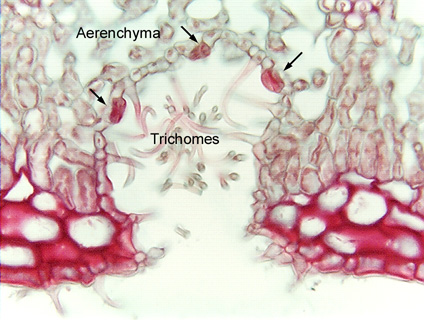Up
Ordinary epidermis
Guard cells
Thick cuticle
Thicker cuticle
Thin cuticle
Parasitic plant
Petal epidermis
Sclerified epidermis
Papillose epidermis
Sculptured cuticle
Elaborate cuticle
Cuticular horns
Radial walls
Cuticle proper
No epidermis
Epidermal peels
Cycad peel
Paradermal
Typical stoma
Sunken stoma
Stomatal orientation 1
Unusual orientation 2
Artifact
Stomata and fibers
Stomatal crypts
Crypts, mag.
Crypt margin
Non-crypt
Water lily
Stomatal channels
Groove, hi mag
Subsidiary cells
Ledges
Papillae
Trichome
Uniseriate hair
Peltate hair, mag
Peltate, lo mag
Branched hairs
Trichome base
Lithocyst, Ficus
Lithocysts, hemp
Bulliform cells
Grass epidermis
Multiple epi
Uniseriate?
Peperomia
| |
 Fig.
10.3-11. Magnification of oleander crypt. The arrows indicate three
stomata present in this small portion of the crypt epidermis. In an SEM view, we
would see many stomata in the bowl-shaped crypt epidermis. The numerous
trichomes prevent the air inside the crypt from being disturbed by wind outside
the crypt. Notice that once carbon dioxide enters the crypt and then one of the
stomatal pores, it encounters a very open aerenchyma that permits it to diffuse
deep into the leaf, away from the stomata. By diffusing deep into the leaf, it
is more likely to enter a photosynthetic cell rather than accidentally diffusing
back out of the leaf. Fig.
10.3-11. Magnification of oleander crypt. The arrows indicate three
stomata present in this small portion of the crypt epidermis. In an SEM view, we
would see many stomata in the bowl-shaped crypt epidermis. The numerous
trichomes prevent the air inside the crypt from being disturbed by wind outside
the crypt. Notice that once carbon dioxide enters the crypt and then one of the
stomatal pores, it encounters a very open aerenchyma that permits it to diffuse
deep into the leaf, away from the stomata. By diffusing deep into the leaf, it
is more likely to enter a photosynthetic cell rather than accidentally diffusing
back out of the leaf.
|
 Fig.
10.3-11. Magnification of oleander crypt. The arrows indicate three
stomata present in this small portion of the crypt epidermis. In an SEM view, we
would see many stomata in the bowl-shaped crypt epidermis. The numerous
trichomes prevent the air inside the crypt from being disturbed by wind outside
the crypt. Notice that once carbon dioxide enters the crypt and then one of the
stomatal pores, it encounters a very open aerenchyma that permits it to diffuse
deep into the leaf, away from the stomata. By diffusing deep into the leaf, it
is more likely to enter a photosynthetic cell rather than accidentally diffusing
back out of the leaf.
Fig.
10.3-11. Magnification of oleander crypt. The arrows indicate three
stomata present in this small portion of the crypt epidermis. In an SEM view, we
would see many stomata in the bowl-shaped crypt epidermis. The numerous
trichomes prevent the air inside the crypt from being disturbed by wind outside
the crypt. Notice that once carbon dioxide enters the crypt and then one of the
stomatal pores, it encounters a very open aerenchyma that permits it to diffuse
deep into the leaf, away from the stomata. By diffusing deep into the leaf, it
is more likely to enter a photosynthetic cell rather than accidentally diffusing
back out of the leaf.